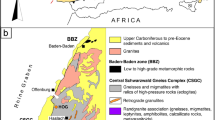Summary
Pre- to early Variscan metamorphosed volcano-sedimentary series of the western (Bergsträsser) Odenwald have been intruded by Variscan calc-alkaline magmatites with plate margin affinities. Within the NE-SW trending metabasic and metapelitic series, intercalations of anomalously aluminous- and iron-rich compositions representing former bauxites are distinguishable. Geochemical data indicate that the Al-, Fe-rich rocks are the metamorphic equivalents of a former bauxitic-ferralitic weathering profile, now comprising spinel fels (top) with relics of pisolitic structures, corundum-chlorite fels, corundum-cordierite-plagioclase gneiss, sillimanite-cordierite-plagioclase gneiss, cordierite-plagioclase gneiss and kinzigite (base) displaying a decrease of weathering in the order as listed. The evolution of such terrestrial sediments is related to specific climatic, environmental, and physico-chemical conditions similar to those of the present-day tropical to subtropical humid regions with high seasonal rains and intensive drainage. Comparison with palaeomagnetic and palaeoclimatic data indicate that the Odenwald metabauxites originally formed during the Lower to Mid-Devonian. Our results imply that, during this geological time span, parts of the precursors of the Mid-German Crystalline Rise not only transversed low latitudes but also were exposed to terrestrial weathering.
Zusammenfassung
Die Geochemie der Metabauxite im Bergsträsser Odenwald (Mitteldeutsche Kristallinschwelle) und ihre Bedeutung für das Paläomilieu
Im westlichen (Bergsträsser) Odenwald intrudierten variszische Plattenrand-Kalkalkali-Magmatite in prä- bis früh-variszische, ehemalige vulkano-sedimentäre Serien. Innerhalb der heute NE-SW streichenden Metabasit- und Metapelitzüge treten lokal Al-Fe-reiche Einschaltungen auf, die strukturell und geochemisch als metamorphe Äquivalente eines ehemaligen bauxitisch-ferralitischen Verwitterungsprofils klassifiziert werden können. Sie umfassen Spinellfelse mit erhaltenen, ehemaligen zonierten Pisolithen, Korund-Chloritfelse, Korund-Cordierit-Plagioklasgneise, Sillimanit-Cordierit-Plagioklasgneise, Cordierit-Plagioklasgneise und Kinzigite. Bauxite können als terrestrische Bildungen nur unter speziellen klimatischen und physiko-chemischen Bedingungen entstehen. Paläomagnetische und paläoklimatische Daten legen die Bildung der ehemaligen Bauxite im unteren bis mittleren Devon nahe. Daraus folgt, daß während dieser geologischen Zeitspanne die Vorläufer der mitteldeutschen Kristallinschwelle bei der Norddrift nicht nur Äquatornähe passierten, sondern auch partiell ungestörte, terrestrische, tropisch-subtropische Verwitterungsprozesse abliefen.
Similar content being viewed by others
Author information
Authors and Affiliations
Additional information
Received June 10, 1999; revised version accepted October 30, 2000
Rights and permissions
About this article
Cite this article
Adusumalli, C., Schubert, W. Geochemistry of metabauxites in the Bergsträsser Odenwald (Mid German Crystalline Rise) and palaeoenvironmental implications. Mineralogy and Petrology 72, 45–62 (2001). https://doi.org/10.1007/s007100170026
Issue Date:
DOI: https://doi.org/10.1007/s007100170026



